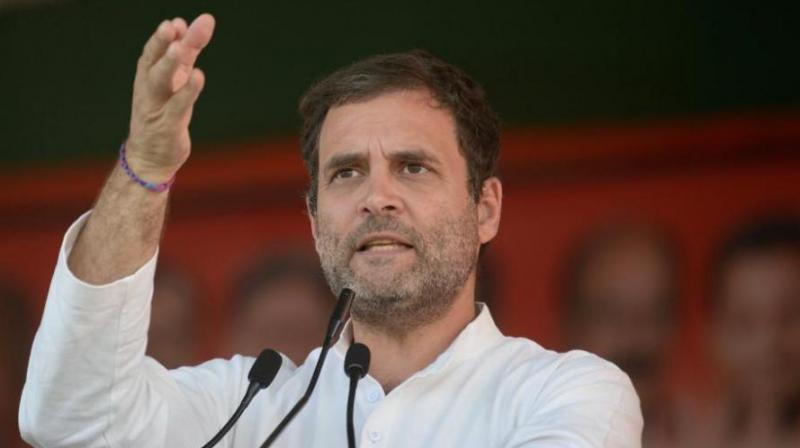The rise of Rahul Gandhi and politics of inclusion

The first year of Rahul Gandhi’s presidency of the Congress Party has been baptism by fire. Often chided as “pappu” or “clown prince”, the Congress chief has given a bloody nose to his opponents in the recently-concluded Assembly polls. Meandering the treacherous path of politics he has taken on the Narendra Modi-Amit shah juggernaut head on, dispelling the notion that the BJP in its current avatar is invincible. His critics have criticised him for “not having fire in the belly” or said that he “cannot match Modi”, but now he has started proving them wrong and even gaining traction even amongst his political opponents. The recent success in the Assembly elections has not only increased the stature of the Congress president in the Opposition, but also within his own party.
The year began poorly for the new Congress president who lost three North Eastern states, further reducing the Congress’ footprint in the Northeast. But in Karnataka he showed some fancy political footwork to retain his party in power. Though in the bargain he had to give away the post of the chief minister, but he ensured that the BJP was steadfastly kept in the Opposition, and the Congress got the post of deputy chief minister. This was a changed Rahul Gandhi from his days as general secretary or vice-president of the Congress who was mostly insistent on building the Congress from grassroots rather than go in for short-term alliances that “damage the cadres in the state”.
In 2007 and 2012 Uttar Pradesh Assembly elections, it was Rahul Gandhi who wanted the Congress to go solo. But now political pragmatism that is the guiding force for the Congress chief.
The major worry for the Congress high command before Rahul took over as president was how will he be perceived by the United Progressive Alliance (UPA) partners. During the UPA years in government, all the dealing with allies was done by the then Congress president, Sonia Gandhi. She commanded respect amongst the allies, and her moral stature had increased substantially when she refused the post of Prime Minister after the 2004 Lok Sabha elections.
But now Mr Gandhi has taken the mantle on himself, with Akhilesh Yadav at the helm of Samajwadi Party, Tejashwi Yadav in the RJD, Omar Abdullah in the National Conference, Jayant Chaudhary in RLD and Stalin in the DMK, the Congress Chief is more at ease in dealing with allies.
Rahul initiated an alliance with long-time Congress opponent and chief minister of Andhra Pradesh, N. Chandrababu Naidu. He has shared the stage with West Bengal chief minister Mamata Banerjee and has a good working relationship with NCP supremo Sharad Pawar.
The Congress was hoping to stitch together a Grand Alliance in Madhya Pradesh and Rajasthan too, but could not achieve it as the BSP chief, Kumari Mayawati, hit out at some Congress leaders. But with the win in both Rajasthan and Madhya Pradesh, Mayawati was the first one to announce the support of her MLAs in the states. As Lok Sabha polls draw closer and talks of grand alliance take place, Mr Gandhi with three states under his belt will surely be in a better position to negotiate seats for his party.
Despite being under constant personal attack from his opponents, Mr Gandhi has not resorted to political sledging and abuses. He has also reprimanded senior leaders of his party who have used intemperate language against the BJP’s leaders. The constant narrative of love, peace and inclusion has been the trademark of Rahul Gandhi’s politics. He has presented himself as somebody who is accessible and ready to learn.
During the Gujarat assembly election campaign, Mr Gandhi was interacting with ad-hoc teachers when one elderly teacher starting narrating her plight and of other teachers, she broke down. Mr Gandhi went up to her and hugged and said the only response as of now I have is this. This won him many accolades as somebody who cares and understands, compared to the “grandstanding” of the BJP top brass. He once again repeated the same thing when after his fiery speech on the no-confidence motion in Lok Sabha, he went and hugged Prime Minister Narendra Modi.
The Congress president in his recent avatar has also tried to shed the image of a pro-minority party. He was under constant attack by the BJP for establishing his Hindu credentials. Not only did he first give out his Hindu ancestry, but also went on to differentiate between Hinduism and Hindutva.
His visits to temples and also a special visit to Kailash Mansarovar has ensured that he cannot be boxed in by the BJP on the issue of Hinduism. At 47 years of age, the Gandhi scion has won his first bout against a formidable opponent. How he fares in the next big national test will depend on how he manages and negotiates within and outside his party.

